
TESTING THE INSTALLATION
After installation is complete and all connections are made, you are ready to test the installation
prior to actual size. Thorough testing should be performed with the boat in the water; however,
you can initially confirm basic operation with the boat trailered.
Press POWER once to turn the unit on. There will be an audible chirp when any button is pressed
that confirms the button press. If the unit does not power-up, ensure that the unit is fully seated
on the mount and that power is available.
The first screen provides four options; Start-up, Options, Simulator, and Diagnostic.
The time remaining before the screen “times out” is shown at the bottom of the screen. If you do
not press any button before the timer reaches 0, the normal operation screen will be displayed. If
the boat is on water, sonar data will begin to appear. If no transducer is connected or detected,
the Portrait will go into simulator mode after the initial menu screen times out.
Note: The transducer must be submerged in water for reliable transducer detection.
If the bottom is visible on-screen with a digital depth readout, the unit is working properly. If the
unit powers-up but fails to display bottom information, the transducer is not properly connected.
Ensure that the boat is in water greater than 2 feet but less than 600 feet deep, and that the
transducer is fully submerged. Remember that the sonar signal cannot pass through air. Refer to
the troubleshooting section of this manual. If the unit is working properly, gradually increase the
boat speed to test high-speed performance. If the unit functions well at low speeds but begins to
skip or miss the bottom at higher speeds, the transducer installation requires adjustment. Refer to
the appropriate transducer installation section for more detail.
Note: It is often necessary to make several incremental transducer adjustments before optimum
high-speed performance is achieved.
Summary of Contents for Wide Portrait
Page 1: ......

































